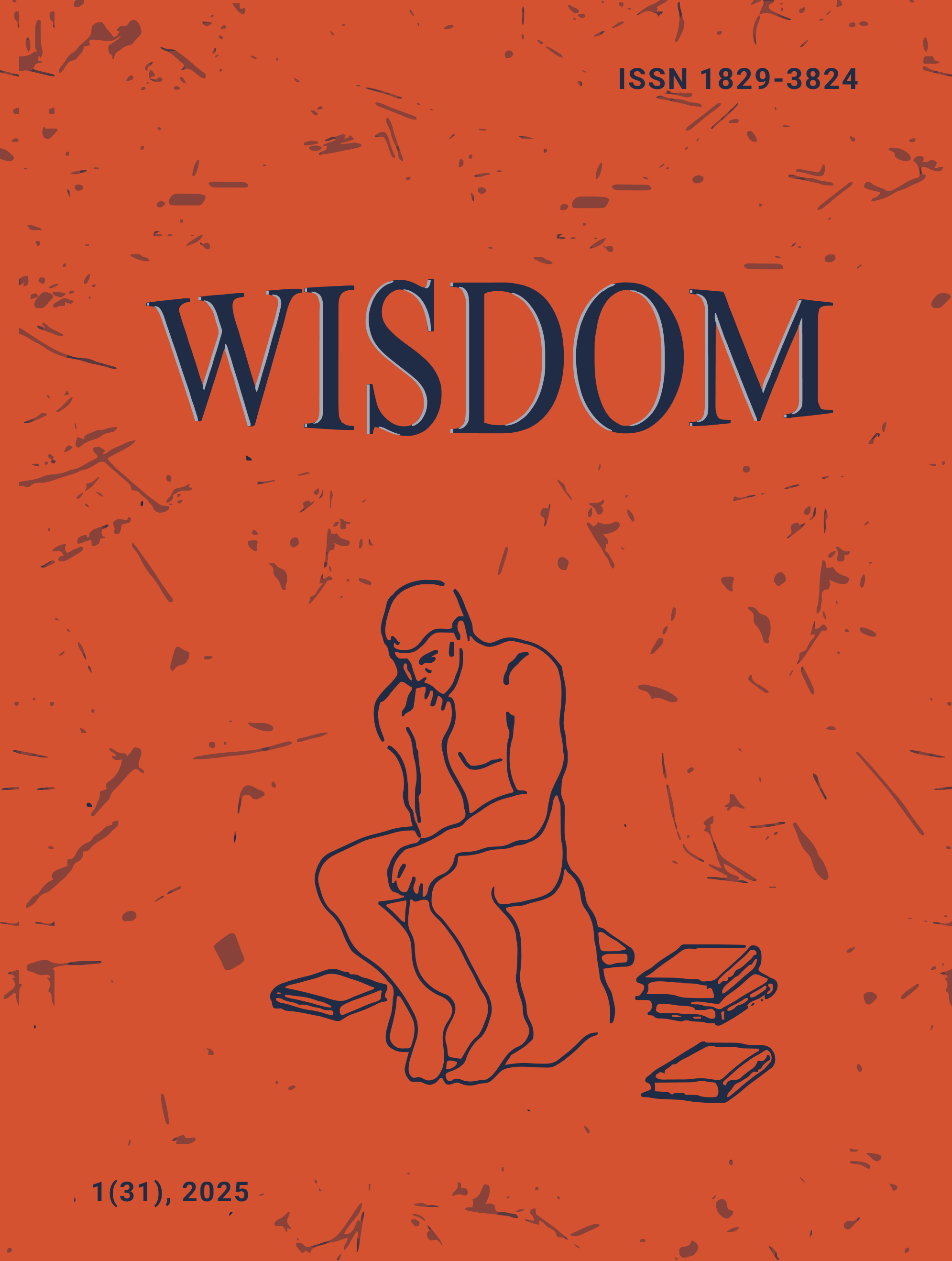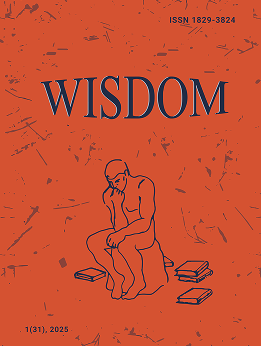A Historical Overview of Stereotyping
DOI:
https://doi.org/10.24234/wisdom.v31i1.1119Keywords:
stereotyping, stereotypes, history, era, culture, human societiesAbstract
Globalization, the process of increased interconnectedness among countries, in other words, unification and uniformity of cultures, lifestyles, and customs globally has become the core aim and modus operandi of today’s societies, by and large. Globalization is in different areas including culture. Although the globalizing machine imposes general standards and expectations while aiming at dismissing local beliefs, habits and rituals, and ethnic cultures, at times it still has not been able to annihilate traditional as well as national values and dogmas because of which cultural stereotypes emerge, regularly.
Nonetheless, stereotyping is not a new concept in human history. The goal of this article is to shed light on the origin and history of stereotyping throughout various periods and disciplines of human history while raising awareness about the urgency of safeguarding ethnic and local customs through stereotyping, amid globalizations.
Downloads
References
AAUW (2024). The Simple Truth About the Gender Pay Gap. The American Association of University Women. “Retrieved October 16, 2024”, from https://www.aauw.org/resources/research/simple-truth/.
American Psychological Association. (n.d.). Culture. In American Psychological Association Dictionary. “Retrieved October 09, 2023”, from https://dictionary.apa.org/culture
American Psychological Association. (2023). Ageism is one of the last socially acceptable prejudices. Psychologists are working to change that. American Psychological Association Publications. “Retrieved October 10, 2024”, from https://www.apa.org/monitor/2023/03/cover-new-concept-of-aging
Bale, A. (2006). The Jew in the Medieval Book: English Anti-Semitisms 1350–1500. Cambridge: Cambridge University Press.
Bem, S. L. (1974). The Measurement of Psychological Androgyny. Journal of Consulting and Clinical Psychology, 42(2). 10.1037/h0036215 DOI: https://doi.org/10.1037/h0036215
Bennett, M. (2013). Entry in C. Cortes (Ed) Multicultural America: A Multimedia Encyclopedia. New York: Sage
Britannica (2024). Stereotype. In Encyclopedia Britannica. “Retrieved September 30, 2023”, from https://www.britannica.com/topic/stereotype-social
Broverman I. K., Vogel S. R., Broverman D. M., Clarkson F. E., & Rosenkrantz P. S. (1972). Sex-Role Stereotypes: A Current Appraisal. Journal of Social Issues, 28(2), 59-78. 10.1111/j.1540-4560. 1972.tb00018.x DOI: https://doi.org/10.1111/j.1540-4560.1972.tb00018.x
Cheryan, S., & Bodenhausen, G. (2000). When positive stereotypes threaten intellectual performance: The Psychological Hazards of “Model Minority” Status. Psychological Science, 11(5). DOI: https://doi.org/10.1111/1467-9280.00277
Collette, A. (2018). Women and Misogyny in Ancient Greek Philosophy. Women In Antiquity. “Retrieved January 25, 2024”, from https://womeninantiquity.wordpress.com/2018/11/27/women-and-misogyny-in-ancient-greek-philosophy/.
Dray, Ph. (2003). Praise for At the Hands of Persons Unknown: The Lynching of Black America. New York City, NY. Penguin Random House Publishing Group
Eagly A. H., & Steffen V. J. (1984). Gender Stereotypes Stem from the Distribution of Women and Men into Social Roles. Journal of Personality and Social Psychology, 46(4). https://doi.org/10.1037/0022-3514.46.4.735 DOI: https://doi.org/10.1037//0022-3514.46.4.735
End Slavery Now. (n.d.). Slavery Today. “Retrieved September 18, 2024”, from https://www.endslaverynow.org/learn/slavery-today.
Erickson. H. (1968). Identity: Youth and Crisis. W.W. Norton & Company.
Yamamoto, K., & Glăveanu, V. (2012). Bridging History and Social Psychology: What, How and Why. Integrative Physiological and Behavioral Science, 46(4). https://doi.org/10.1007/s12124-012-9213-z DOI: https://doi.org/10.1007/s12124-012-9213-z
Heng, G. (n.d.). Race and Racism in the European Middle Ages. Getty. “Retrieved September 20, 2024”, from https://www.getty.edu/art/exhibitions/outcasts/downloads/heng_race_racism.pdf. DOI: https://doi.org/10.5040/9781350895690.004
Jenkins, D “(Director)”. (2023). The Chosen. [Film]. Netflix. “Retrieved October 1, 2024” from www.netflix.com
Knights, M. (2014). Historical Stereotypes and Histories of Stereotypes. In: Tileagă, Cristian and Byford, Jovan, (Eds.) Psychology and history: Interdisciplinary Explorations. Cambridge, United Kingdom: Cambridge University Press. DOI: https://doi.org/10.1017/CBO9781139525404.017
Kurtz-Costes, B., Copping, K. E., Rowley, S. J., & Kinlaw, R. C. (2014). Gender and Age Differences in Awareness and Endorsement of Gender Stereotypes About Academic Abilities. European Journal of Psychology of Education, 29(4). doi:10.1007/s10212014-0216-7 DOI: https://doi.org/10.1007/s10212-014-0216-7
Lippa R. A., Preston K., & Penner J. (2014). Women’s Representation In 60 Occupations from 1972 to 2010: More Women in High-Status Jobs, Few Women in Things-Oriented Jobs. PLOS One. “Retrieved October 10, 2024”, from https://doi.org/10.1371/journal.pone.0095960. DOI: https://doi.org/10.1371/journal.pone.0095960
Lippmann, W. (1922). Public Opinion. New York: Harcourt Brace.
Lowe, D. (2019). Aristotle’s Defense of Slavery. 1000 Word Philosophy. “Retrieved April 13, 2024”, from https://1000wordphilosophy.com/2019/09/10/aristotles-defense-of-slavery/.
Lumen Learning (2019). Culture and Religion in Pre-Islamic Arabia. “Retrieved May 17, 2024”, from https://courses.lumenlearning.com/suny-hccc-worldcivilization/chapter/culture-and-religion-in-pre-islamic-arabia/.
Mann, S. (2016). Psychology A Complete Introduction. Great Britain: John Murray Learning.
Mark, J. (2019). Ancient Roman Society. World History. “Retrieved April 20, 2024”, from https://www.worldhistory.org/article/1463/ancient-roman-society/.
Merriam-Webster (n.d.). Stereotype. In Merriam-Webster.com dictionary. “Retrieved October 21, 2023” from https://www.merriam-webster.com/dictionary/stereotype
Merriam-Webster. (n.d.). Stereotype. In Merriam-Webster.com dictionary. “Retrieved October 21, 2023” from https://www.merriam-webster.com/dictionary/stereotype#dictionary-entry-2
Oxford English Dictionary. (2024). Stereotype. In Oxford English Dictionary. “Retrieved September 30, 2023” from https://doi.org/10.1093/OED/7045181567. DOI: https://doi.org/10.1093/OED/7045181567
Puck Magazine. (1895). John Bull’s Dilemma. [Photograph]. Getty Images. https://www.gettyimages.com/detail/news-photo/the-armenian-genocide-refers-to-the-deliberate-and-news-photo/1354476342
Schneider, D. (2005). The Psychology of Stereotyping. The Guilford Press. NY, New York
Radford, M “(Director)”. (2004). The Merchant of Venice. [Film]. Prime Video. “Retrieved October 15, 2024”, from https://www.amazon.com/Merchant-Venice-Al-Pacino/dp/B00AO9Y0DU
Smithsonian (n.d.). Blackface: The Birth of An American Stereotype. National Museum of African American History. https://nmaahc.si.edu/explore/stories/blackface-birth-american-stereotype
Tajfel, H., & Turner, J. C. (1986). The Social Identity Theory of Intergroup Behavior. In Worchel, S. & Austin, W. (Eds.), Psychology of Intergroup Relations. Nelson Hall.
Office of the United Nations High Commissioner for Human Rights. (1996-2024). About Human Rights and Persons with Disabilities. United Nations Human Rights Office of the High Commissions. “Retrieved October 18, 2024”, from https://www.ohchr.org/en/disabilities/about-human-rights-persons-disabilities
Wood, W. & Eagly, A. H. (2012). Biosocial Construction of Sex Differences and Similarities in Behavior. In Advances in Experimental Social Psychology, Vol. 46. Eds Olson J. M., Zanna M. P. Academic Press. DOI: https://doi.org/10.1016/B978-0-12-394281-4.00002-7
Zhang B, Hu Y, Zhao F, Wen F, Dang J., & Zawisza M (2023). Editorial: The Psychological Process of Stereotyping: Content, Forming, Internalizing, Mechanisms, Effects, and Interventions. Frontiers in Psychology. 13:1117901. “Retrieved March 10, 2023”, from doi:10.3389/fpsyg.2022.1117901 DOI: https://doi.org/10.3389/fpsyg.2022.1117901
Downloads
Published
How to Cite
Issue
Section
License
Copyright (c) 2025 Mariana Avetisyan

This work is licensed under a Creative Commons Attribution-NonCommercial 4.0 International License.
Creative Commons Attribution-Non-Commercial (CC BY-NC). CC BY-NC allows users to copy and distribute the article, provided this is not done for commercial purposes. The users may adapt – remix, transform, and build upon the material giving appropriate credit, and providing a link to the license. The full details of the license are available at https://creativecommons.org/licenses/by-nc/4.0/.















